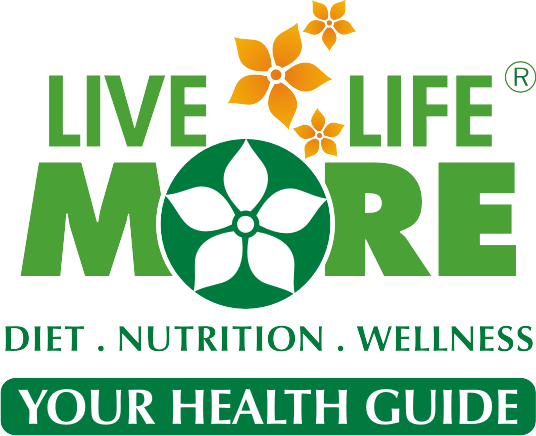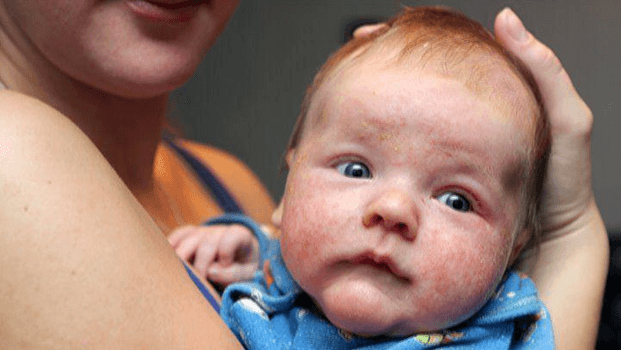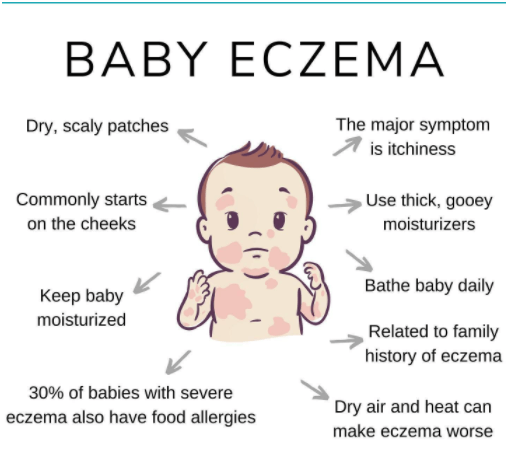Eczema is a common, long-term skin condition characterized by inflamed, scaly patches and skin infections. It can cause severe itching and discomfort to the skin. Eczema typically appears during the first few months of life. Many children outgrow eczema by adolescence, but some people have it their entire lives. You may wonder how to get rid of eczema scars on babies? Here is some helpful information regarding this; read more to know everything.
Eczema does not spread. Children with eczema frequently have other allergy-related conditions, such as asthma or hay fever, or have family members who do. Atopic dermatitis is another name for eczema.
Causes
Eczema is a situation that comes and goes. Several factors, including: can cause a flare-up of eczema.
- Stress
- Food allergies or intolerances
- Infections caused by viruses or bacteria
- Overheating with clothing, blankets, or heaters
- Exposure to allergens like animal fur or dust mites
- Contact with irritating chemicals such as soaps or bubble baths or irritating fabrics such as coarse-fibred wool and polyester
However, there isn’t always an apparent cause for a flare-up.
Symptoms
Eczema causes itchy, scaly, bumpy, inflamed patches of skin in children. The inflamed patches may appear red on children with lighter skin, and patches on children with darker skin may appear brown, purple, or gray.
Small eczema patches that are not treated promptly and properly can cause the rest of the skin to become inflamed and the patches to spread.
Eczema patches can also crack, weep, and bleed, especially if your child scratches frequently. Bacteria and viruses can enter the skin through these cracks, resulting in infections. As a result, light-brown or yellow crusts, blisters, or pain develop.
If the infections are severe, your child may experience fever, headache, and fatigue.
If eczema is not treated correctly, the skin may appear thickened and dry. When eczema is appropriately treated, the skin is usually normal with no scarring.
The severity of eczema symptoms varies with age.
Babies may develop eczema on large areas of their bodies, particularly their cheeks, heads, and bodies. They may also have scratches from scratching the itch with their fingernails. Babies who have nappy rash may have eczema in their diaper areas.
Patchy eczema on the wrists, elbows, ankles, and knees is common in toddlers and preschoolers.
Patches of thick, inflamed, bumpy eczema can appear anywhere on a teenager’s body, including:
- Folds of their elbows
- Behind their knees
- Around their necks, eyelids, ears, and hands.
Treatment
Eczema is incurable. However, it is manageable by preventing and treating flare-ups as soon as they occur.
If your child’s skin is itchy and inflamed, they will most likely require corticosteroid ointment or cream. Mild corticosteroids can be purchased without a prescription at your pharmacy to treat mild eczema.
The most common is 1% hydrocortisone cream. If the over-the-counter products aren’t working or if your eczema is severe, you’ll need to see a doctor for a prescription for a more potent corticosteroid.
Pimecrolimus, a non-steroidal cream, is another eczema treatment. A doctor may prescribe this cream for children with mild to moderate eczema on the face and body folds.
If your child is scratching with a rash, talk to your doctor about using an antihistamine for a few days. This, in conjunction with a corticosteroid cream, may provide your child with some relief and aid in the resolution of the flare-up.
If your child’s eczema rash becomes infected, your doctor will prescribe an antibiotic course.
Home Remedies
Avoid the Things that Cause Irritation
Some of the most common things that can irritate your child’s skin are:
- Acidic foods, dummies, and dribbling
- Allergens in the environment such as pets, grasses, dust mites, and pollen
- Toothpaste that lists sodium lauryl sulfate as an active ingredient
- Soaps, bubble baths, detergents, alcohol wipes, and baby wipes containing fragrance or an ingredient called methylisothiazolinone
Apply Moisturizer Regularly
- Using a thick, unscented moisturizer regularly – twice a day is ideal. Because it absorbs better into the skin after a bath or shower, moisturizer is best used immediately after.
- Because ointments are greasier than creams, they often work better on dehydrated skin.
- When your child takes a bath, they could also use a simple, fragrance-free moisturizing bath oil.
Give Warm, Short Shower and Bath
Make sure your child’s baths or showers are brief and that they are using warm, but not hot, water. In addition, your child does not need to bathe or shower more than once per day. Instead of giving your baby or toddler a full bath, you could wash their face and bottom.
Keep your Baby Cool
- Heaters should not be turned up too high.
- Keep your child away from direct heat sources such as heaters and fireplaces.
- Avoid overdressing your child or putting too many layers on their bed.
- Cotton underwear and clothing are preferable to coarse-fibred wool and polyester. Superfine merino wool is acceptable because it is breathable and does not irritate the skin.
Taking a bath in oatmeal
Oatmeal baths are usually taken to make your skin healthier and treat some skin-related issues as well. Antioxidants and anti-inflammatory compounds in oatmeal can help to decrease inflammation and irritation while also rejuvenating the skin.
Oatmeal may also be used as an exfoliator to help the skin retain moisture, exfoliate dead skin cells, and decrease scarring. Soak your baby’s body in an oatmeal bath for around 40 minutes every day to heal eczema scars. It is recommended to apply oatmeal lotion on your skin as well.
Honey
Honey’s anti-inflammatory, antibacterial, and therapeutic effects are well-known. There are various types of honey and every single one has its own properties. Manuka honey is a highly concentrated type of honey with added antibacterial properties.
Manuka honey may be used directly to eczema rashes to help minimize scarring. You can also use it to make a daily sugar scrub by mixing it with sugar. For better results, repeat the process. If your symptoms worsen, see your doctor about other options.
Vinegar of apple cider (ACV)
Want to renew your skin or want to get younger again? Apple cider vinegar is highly recommended as it consists of multiple vitamins and healthy minerals for the skin. The antibacterial and antibiotic effects of ACV are well-knon. It’s also used as an exfoliator since it aids in the removal of dead skin and promotes the development of healthy skin.
Dilute a tiny quantity of ACV with water to treat eczema scars. Allow the solution to settle on your skin for a few minutes. Rinse off the ACV mixture with water and repeat the treatment on a regular basis.
You should consult a dermatologist before starting any treatment. The skin of the babies is skin and should be treated with caution. It is better to get advice from an experienced doctor. You can book an appointment to get the best advice for your babies from Best Dermatologist through Marham.
FAQs
1. Do eczema scars fade over time?
It is all determined by the severity of your eczema and the type of scarring. Scars usually fade with time. Some, however, never completely disappear.
2. Why do dark spots appear as a result of eczema?
Inflammation causes darker patches of skin (hyperpigmentation) in eczema, which stimulates melanocytes – the skin cells that give skin its color – to increase melanin synthesis (making skin pigment).
3. Is Vaseline safe to use on eczema?
Vaseline is well tolerated and effective on sensitive skin, making it an excellent treatment for eczema flare-ups.





